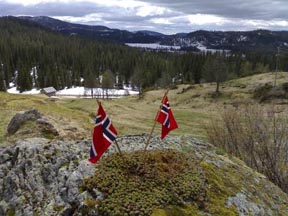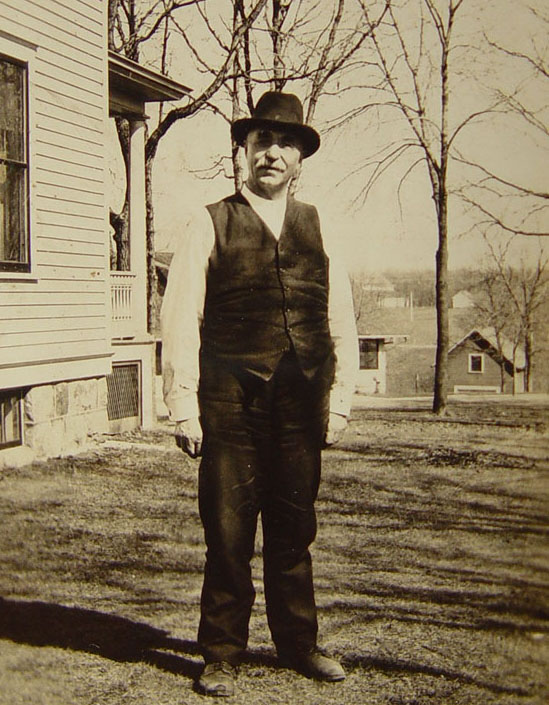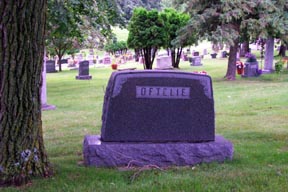
Torkel’s birthplace is
located between the fields and the small lake on the picture
Photo by Olav Førstoyl May 17,
2008

Photograph from
Telesoga,
1911, Volume 10

Torkel is buried in Oak Grove Cemetery, Fergus
Falls MN, next to his wife Signe
Photo by Gene Estensen
TORKEL OFTELIE
by Bjørgulv Bjørnaraa
I greet you, Torkel; praise I speak,
Saga-writer, from the North.
You, steadfast, like a mountain peak,
Motherland's voice stood forth.
You were an honor for this land -
A blossom from Norway's green;
Who wove a beautiful heritage band
Father and son between.
You followed the Teler's courageous trail
And deeds in this land;
And told the ever-inspiring tale
Of Old Norse in Vinland.
Yes, from their birthright's legal due
You followed them all the way.
They earned the highest praise; and you
Such words of praise could say.
As Rjukan's thundering waterfall
Sings out a conqueror's song;
As trolls, high in their mountain hall
Often shouted loud and long;
So you called out from this new shore
In Telemark's own tongue;
And Telesoga offered more
Inspiring old and young.
You conjured up a treasure trove
Of sagas - living gold;
From people's past, you, skillful, wove
A vision they could hold.
You traveled round for many a day,
So curious and intent;
When Telers met to say their say
You joined their merriment.
The pay you got was thanks, alone,
But what to us you gave
Shall be inscribed in timeless stone
To stand above your grave!
Then will our people stand in grief,
Knowing what now must end,
And lay each flowery tribute sheaf
To honor their lost friend.
So you must live in joy and grace,
Live to a ripe old age.
We need such champions of our race
To preserve our heritage.
You were a faithful messenger,
Your "call" a demanding one;
We thank you for each "priceless pearl"
And all that you have done.
|
Torkel Oftelie's dedicated collection
and reporting of the history of Telemark settlements in America allow us
to see those communities and our ancestors in a very personal way.
This great gift to all of us is incalculable. Torkel provided the kind
of hard-working leadership that has allowed Telelaget to remain vital
and relevant to its descendant community for decades beyond his death.
Torkel was born on the 23rd of January, 1856, at Kosi,
originally a husmannsplass (tenant farmer's dwelling) on the
Førstøyl farm in Høysdalsmo, Telemark. The property had been sold
in the 1840's to Tarkjell Gunleiksen Nigard Ofte (1793-1853), first
husband of Torkel's mother, Anne Halvorsdtr Mjaugedal (Oct 25 1815-May
12 1887) and she inherited the property when Tarkjell died.
Tarkjell and Anne had three children:
-
Tore, born April 3, 1845,
emigrated to America where she married a man named Cameron. Their
son Kenneth Potten Cameron lived in Brooklyn NY.
-
Halvor, born May
14, 1847, was a sailor who spent a few years in the USA before moving to
Curitiba, Brazil, where he planned to start a Norwegian settlement.
-
Aslak, born September 3, 1848, died before he was 3 months old, on
November 24, 1848.
Anne married Halvor Jonsen Oftelid (Sep 2, 1832-Mar
14, 1912) on October 27, 1854. Torkel was the oldest and, in keeping
with tradition, was named for his mother's deceased first husband.
He had two younger siblings: Jon, who was born November 13, 1857
and died December 31, 1933. His youngest brother Aslak did not see
his second birthday: he was born March 7, 1860 and died May 21, 1861.
For a time the family lived at Ofte Uppigard, the farm
owned by Torkel's grandparents and inherited by his brother Jon.
In 1860, Torkel's father Halvor purchased Nord Oftelid, where Torkel and
Jon spent their growing up years. Had he remained in Telemark, this farm
would have been Torkel's birthright. Instead, Kjetil Ofte
purchased the farm from his grandfather and passed it on to his son Jon
K. Ofte (1914-2000). (In 2007, Jon's widow Helbjørg still lived on Nord
Oftelid.)
In 1873, Torkel graduated from Kviteseid Seminary, and
went on to spend the next 11 years as a teacher in Norway. He spent
1875-76 at Morgedal and Kviteseid; 1876-1881 in Vrådal and Kviteseid;
and 1881-1886 at Høydalsmo and Lårdal. In addition, Torkel attended
Asker Seminary for one year in 1883.
Signe Groven was born in 1858 on Gøytil in Lårdal.
Her parents were Aasmund and Margit Groven. In 1884 she emigrated
to America with her brother Knut and his family. Torkel wrote to her and
asked her to return to Norway, but she convinced him to come to America
instead. Torkel immigrated in 1886, and married Signe on September
28, 1886 at the Teisberg home in Fergus Falls MN. Reverend O. N. Fosmark
officiated, and A. G. Teisberg and T. G. Bershot were witnesses.
Torkel wrote that during his first two years in
America he worked at odd jobs: on the railroad, on a farm, threshing at
harvest time, taught religion and singing at Norwegian schools in Otter
Tail and Grant counties, Minnesota, in the winters. In 1888, he became
co-editor of the Norwegian language paper the Ugeblad Fergus
Falls. He earned $35 a month.
Signe and Torkel settled into a 2-story home at 517
Cleveland Avenue in Fergus Falls. They raised five children there:
Halvor (1887-1947), Maria (1889-1895), Anne (1890-1975) Margaret
(1897-1977) and Osmund (1899-1975).
Torkel and his partner, Ole Hagen of Crookston MN
published Rodhuggeren in Fergus Falls. The paper was populist
in politics and considered the strongest paper of its kind in northern
Minnesota. The paper merged with other papers and was moved to Fargo in
1898. The new paper circulated as Fram. It is not known how
long Torkel wrote for Fram.
In 1900, Torkel homesteaded in North Dakota. He
sold the property for "quite a profit" a few years later.
At some point between 1906-1910, Torkel was a member
of the Ljom Singing Society of Fergus Falls. The group was organized in
1883. It is not known when Torkel joined or how long he was a member. He
is pictured with the group in a photo believed to have been taken in
either 1906 when its beautiful banner was dedicated, or in 1910 when
they won the loving cup in Sioux Falls SD. In 1906 he attended a
week-end convention of the Sons of Norway in Fargo.
In 1907 he was part of a planning committee of the
Norwegian Literary Society whose objective was to perpetuate the
literature and history of Norway. Torkel published a book entitled
Tiriltunga about Norwegian folk music in Telemark. His writing has
references to Norse Mythology. He taught music, and for at least two
years was a member of the Ljom Singing Society of Fergus Fall. He
admired poets, such as Vinje, and wrote poetry himself. "When I read
Vinje's poems, I could almost weep, because I couldn't write anything
like that." He included some of his own poetry in issues of Telesoga.
Here is one of his amusing verses written in reflection of Robert Burns:
In public I wish heartily
To see myself as others see me;
Then I would see what never was clear,
And find my faults both there and here.
It was also in 1907 that he participated in the
founding of Telelaget and was elected its historian and soga
writer. It seems that all his special interests and experience prepared
him for this 20-year commitment. From the start of his work as historian
at the age of 51, he was concerned that Norwegians were too quick to
drop their native customs, especially in the naming of children.
Addressing the first stevne that same year, he said,
"A day will come when we are proud of our ethnic heritage." "There are
many who will ask," he said, "'What do we gain by doing this work?' I am
certain this is of great value for our people. This must be done if we
are going to be aware of family and ancestors among our people in the
coming generations...The day will arrive," he said, "when Norwegians
will not be embarrassed about being Norwegian and the work we have
started will then be appreciated. It is then that people will understand
our nationalistic tasks and that we can or should set our mark here, as
our ancestors did when they traveled in Europe...We need to leave an
impression. This nation is composed of many different people, like the
rainbow with its distinct colors. Let there be a Norwegian color in the
American rainbow."
From 1907-1926 Torkel traveled by horse and buggy, and
sometimes on foot or by train, through the Telemark settlements in
Minnesota, Wisconsin, Iowa, Montana, the Dakotas, and Nebraska. He
worked at his own expense, so some of this time he sold woollen goods
for a wool factory in Fergus Falls to raise money to finance his
journeys. He did most of the writing for Telesoga himself. In some cases
he had others write. He enlisted his good friend, the famous artist
Herbjørn Gausta, to illustrate some of the issues.When Gausta died,
Torkel was instrumental in raising money for a monument for Gausta.
The first issue of the
Telesoga
was published in 1909. Torkel published 53 issues between 1909 and
1924. During these years include biographies, histories, sketches,
genealogies, anecdotes, poems [some were his own], amusing events, and
photographs. In 1926, at the age of 70, Torkel wrote and published the
128-page Yearbook for Telelaget.
Torkel spent 3 months in Norway beginning in late May
of 1935. The people in his home district held three large public
meetings in his honor. On his return to America, he spent three
days in Washington and received a guided tour from Senator Shipstead's
secretary.
1936, July 2 Signe died,
just months before their golden wedding anniversary; she had been in
poor health for several years. Torkel's daughter Anne Thurneau, whose
husband died in 1918, came to live with Torkel. She was his constant companion until his death.
Anne and Torkel travelled to Burbank, California,
to spend the winter with Torkel's daughter Margaret. He died there
on November 4, 1943 from complications of diabetes. His body was
brought back to Fergus Falls for burial in Oak Grove Cemetery. A service
was held at Bethlethem Lutheran Church with Rev. Skepstad officiating.
The following verses are from the final stanza of
Rev. J. O. Sæter's memorial poem honoring Torkel:
So takk då, Torkel! Ditt namn skal minnast
So lenge nordmenn i vesten finnast.
Du elska Norig, di gamle mor.
No søv du signa i vestens jord.
So thank you, Torkel, your name will be remembered
As long as there are Norwegians in the West.
You loved Norway, your old mother,
Now you sleep, blessed, in western earth.
Biographical information gathered by Alice Kirn
|






